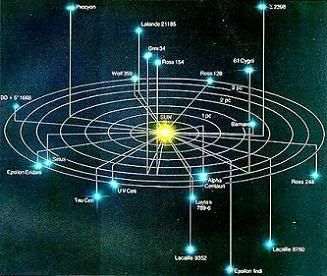Post by glactus on Mar 9, 2008 6:39:10 GMT

Sky map with Alpha Centauri labeled.
A rocky planet similar to Earth may be orbiting one of our nearest stellar neighbors and could be detected using existing techniques, according to a new study led by astronomers at the University of California, Santa Cruz.
The closest stars to our Sun are in the three-star system called Alpha Centauri, a popular destination for interstellar travel in works of science fiction.

Radial clock map. Alpha centauri is at 5 o'clock
UCSC graduate student Javiera Guedes used computer simulations of planet formation to show that terrestrial planets are likely to have formed around the star Alpha Centauri B and to be orbiting in the "habitable zone" where liquid water can exist on the planet's surface. The researchers then showed that such planets could be observed using a dedicated telescope.
"If they exist, we can observe them," said Guedes, who is the first author of a paper describing the new findings. The paper has been accepted for publication by the Astrophysical Journal.
The Doppler detection method, which has revealed the majority of the 228 known extrasolar planets, measures shifts in the light from a star to detect the tiny wobble induced by the gravitational tug of an orbiting planet.
"Factors that favor the use of this technique for Alpha Centauri B include the brightness of the star and its position in the sky, which gives it a long period of observability each year from the Southern Hemisphere", Laughlin said.
"I think the planets are there, and it's worth a try to have a look."

To gaze in awe
credits:
This article has been adapted from material supplied by the University of California, Santa cruz
This is part text only. See image, full text and all scientists involved at sciencedaily.com
www.sciencedaily.com/releases/2008/03/080307121613.htm
Sky map with Alpha Centauri: NOAA Earth System Research Laboratory.
Apha Centauri clock map:
www.blog.speculist.com/archives/naechste.jpg





